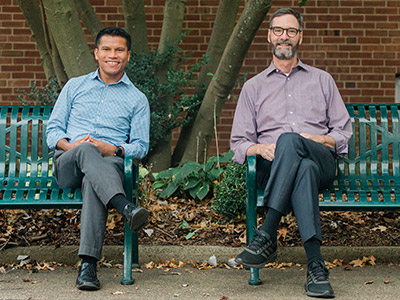Mission as Embodied by Jesus Christ
It always feels good to reach a finish line, and World Mission Initiative Director the Rev. Dr. Hunter Farrell (pictured sitting right) and Associate Director the Rev. Balajiedlang Khyllep (pictured sitting left) and published an important project seven years in the making. Dr. Farrell explains, “This book is the result of multiple surveys and conversations with more than 1,400 mission leaders across U.S. Christian traditions—mainline Protestants, evangelicals, and Roman Catholics.”
Across these diverse traditions, similar patterns were playing out.
“Many congregations seemed to be engaging in the same mission strategies: child sponsorship, short-term mission trips, prepared meal-packaging events, and support of orphanages,” Dr. Farrell says. “Billions of dollars go to these types of mission work each year, yet these strategies are often extraordinarily ineffective and inefficient. When we’re tempted to ‘send money’ or offer our volunteer time to do for families what they could do themselves, our mission strategies may be building on colonial assumptions,” he explains, “or the more recent focus on self-transformation (‘selfie mission’) that short-circuits mission as embodied by Jesus Christ.”
“In contrast,” he explains, “Jesus spent 30 years learning from the people around him before he preached his first sermon. His mission wasn’t a task list, but a spreading circle of human relationships that changed the world. We need to take that seriously.”
Through their many interviews and conversations, the two authors found that mission leaders feel disconnected from each other and that they desire to learn best practices for drawing their people more deeply into God’s mission. So the project took shape as a guide that addresses the most frequently identified needs in local church mission engagement. It offers three foundational stones—a mission theology of companionship, an invitation to cultural humility, and the power of co-development—that congregational mission leaders and churches can implement in every mission activity.
The book also includes a “toolkit” of seven resources designed for congregational mission leaders to use with their congregation. These tools were designed to accompany and apply the concepts lifted up in the book. In this sense, the book aims to offer suggestions and equip mission leaders in both theory and practice.
The two authors have had the chance to take it on the road, using parts of the book as they were being written to engage in real training and dialogue with church leaders and mission teams. The results have been fruitful and encouraging.
Their book, titled Freeing Congregational Mission: A Practical Vision for Companionship, Cultural Humility, and Co-Development, is published by InterVarsity Press-Academic.

